Bibliometric Analysis of Argan (Argania spinosa (L.) Skeels) Research: Scientific Trends and Strategic Directions for Climate-Resilient Ecosystem Management
Abstract
1. Introduction
2. Materials and Methods
2.1. Data Collection and Search Strategies
2.2. Analytical Methods
2.2.1. Bibliometric Approach and Analysis Tools Using the Bibliometrix Package in R
2.2.2. Analysis Using VOSviewer Software
3. Results and Discussion
3.1. Descriptive Statistics of the Database
3.2. Trends in Scientific Production
3.3. Intellectual Structure
3.3.1. Performance Analysis of Top Ten Authors and Sources
3.3.2. Analysis of Top Ten Productive Countries
3.4. Social Structure
3.4.1. Analysis of Authors’ Collaborations
3.4.2. Analysis of Country Collaborations
3.5. Conceptual Structure: Co-Occurrence Analysis
3.6. Scientific Advances and Remaining Gaps in Argan Tree Studies: Research Perspectives
3.6.1. Analysis of Research to Date
3.6.2. Research Gaps
3.6.3. Future Research Perspectives
4. Conclusions
Supplementary Materials
Author Contributions
Funding
Data Availability Statement
Acknowledgments
Conflicts of Interest
References
- Benabid, A.; Fennane, M. Connaissances Sur La Végétation Du Maroc: Phytogéorgrafie, Phytodociologie et Séries de Végétation. Lazaroa 1994, 4, 21–97. [Google Scholar]
- Benabid, A. Flore et Écosystèmes Du Maroc: Évaluation et Préservation de La Biodiversité; Ibis Presse: Paris, France, 2000. [Google Scholar]
- FAO. L’état Des Ressources Génétiques Mondiales: Rapport National. Le Royaume Du Maroc (Projet TCP/RAB/3303-BABY 2); Organisation des Nations Unies pour l’Alimentation et l’Agriculture: Rome, Italy, 2013. [Google Scholar]
- FAO; Plan Bleu. État Des Forêts Méditerranéennes 2018; Organisation des Nations Unies pour l’alimentation et l’agriculture: Rome, Italy, 2020; ISBN 978-92-5-132095-2. [Google Scholar]
- Emberger, L. Le Domaine Naturel de L´arganier. Bull. Soc. Bot. Fr. 1925, 72, 740–774. [Google Scholar] [CrossRef]
- Emberger, L. Les Limites Naturelles Climatiques de l’arganier. Bull. Soc. Sci. Nat. Maroc 1925, 5, 84–97. [Google Scholar]
- M’Hirit, O.; Benzyane, M.; Benchekroun, F.; El Yousfi, S.M.; Bendaanoun, M. L’arganier: Une Espèce Fruitière-Forestière à Usages Multiples; Mardaga Press: Sprimont, Belgium, 1998. [Google Scholar]
- Msanda, F.; El Aboudi, A.; Peltier, J.P. Biodiversité et Biogéographie de l’arganeraie Marocaine. Cahiers Agric. 2005, 14, 357–364. [Google Scholar]
- Aït Hamouda, T.; Bendou, S.; Abdoun, F. L’arganeraie Algérienne, Caractéristiques Écologiques et Structurales. In Proceedings of the International Congress on the Argan Tree, Agadir, Morocco, 19–21 December 2013; pp. 9–11. [Google Scholar]
- Stride, G.; Nylinder, S.; Swenson, U. Revisiting the Biogeography of Sideroxylon (Sapotaceae) and an Evaluation of the Taxonomic Status of Argania and Spiniluma. Aust. Syst. Bot. 2014, 27, 104–118. [Google Scholar] [CrossRef]
- Peltier, J.-P. La Végétation du Bassin Versant de l’Oued Sous (Maroc). Ph.D. Thesis, Université Scientifique & Médicale de Grenoble, Grenoble, France, 8 October 1982. [Google Scholar]
- Tazi, M.R.; Berrichi, A.; Haloui, B. Esquisse Cartographique de l’aire de l’arganier Argania spinosa (L.) Skeels Au Maroc Nord-Oriental. Bull. Sci. Inst. Rabat Life Sci. Sect. 2003, 25, 53–55. [Google Scholar]
- Faouzi, K.; Rharrabti, Y.; Boukroute, A.; Mahyou, Y. Cartographie de l’aire de Répartition de l’arganier (Argania spinosa L. Skeels) Dans La Région Orientale Du Maroc Par Le GPS Combiné Au SIG. Nat. Technol. Nat. Technol. 2015, 12, 16–24. [Google Scholar]
- Baumer, M.; Zeraia, L. La plus Continentale Des Stations de l’arganier En Afrique Du Nord. Rev. For. Française 1999, 51, 446–452. [Google Scholar] [CrossRef]
- Ould Safi, M.; Kechairi, R.; Benmahioul, B. Situation Sanitaire de l’arganeraie de Tindouf (Algérie): Rôle Des Termites et Champignons. Associés. Forêt Méditerranéenne 2015, 36, 313–318. [Google Scholar]
- NFI. National Agency for Water and Forests, Morocco. Map; NFI: Rabat, Morocco, 2018. [Google Scholar]
- Metougui, M.L.; Mokhtari, M.; Maughan, P.J.; Jellen, E.N.; Benlhabib, O. Morphological Variability, Heritability and Correlation Studies within an Argan Tree Population (Argania spinosa (L.) Skeels) Preserved in Situ. Int. J. Agric. For. 2017, 7, 42–51. [Google Scholar] [CrossRef]
- Benzyane, M.; Naggar, M.; Lahlou, B. L’aménagement Des Forêts Sud-Méditerranéennes: Quelle Approche? Forêt Méditerranéenne 2002, 23, 201–210. [Google Scholar]
- Naggar, M.; Mhirit, O. L’arganeraie: Un Parcours Typique Des Zones Arides et Semi-Arides Marocaines. Sci. Chang. PlanétairesSécheresse 2006, 17, 314–317. [Google Scholar]
- Prendergast, H.D.; Walker, C. The Argan: Multipurpose Tree of Morocco. Curtis’s Bot. Mag 1992, 9, 75–85. [Google Scholar] [CrossRef]
- Lybbert, T.J.; Aboudrare, A.; Chaloud, D.; Magnan, N.; Nash, M. Booming Markets for Moroccan Argan Oil Appear to Benefit Some Rural Households While Threatening the Endemic Argan Forest. Proc. Natl. Acad. Sci. USA 2011, 108, 13963–13968. [Google Scholar] [CrossRef]
- Chakir, H. Argan Oil: A Niche Market in Finland: Market Potential, and Business Strategy. Bachelor’s Thesis, Tampere University of Applied Sciences, Tampere, Finland, 2024. Available online: https://www.theseus.fi/handle/10024/871247 (accessed on 27 March 2025).
- Moukrim, S.; Lahssini, S.; Rhazi, M.; Alaoui, H.M.; Benabou, A.; Wahby, I.; El Madihi, M.; Arahou, M.; Rhazi, L. Climate Change Impacts on Potential Distribution of Multipurpose Agro-Forestry Species: Argania spinosa (L.) Skeels as Case Study. Agrofor. Syst 2019, 93, 1209–1219. [Google Scholar] [CrossRef]
- Perry, W. Social Sustainability and the Argan Boom as Green Development in Morocco. World Dev. Perspect. 2020, 20, 100238. [Google Scholar] [CrossRef]
- Karmaoui, A. Ecosystem Services of the Argan Forest, the Current State and Trends. Adv. Res. 2016, 8, 1–13. [Google Scholar] [CrossRef]
- FAO. Women’s Participation in National Forest Programmes: Formulation, Execution and Revision of National Forest Programmes (Technical Note); FAO: Rome, Italy, 1997. [Google Scholar]
- Lamhamedi, M.S.; Bakry, S.H.; Hamrouni, L. Mise En Application de Nouvelles Innovations Techniques, Technologiques et Biotechnologiques Pour La Restauration, La Domestication et l’intensification de La Culture de l’arganier. In Proceedings of the Actes du 3e Congrès International de l’Arganier, Agadir, Morocco, 17–19 December 2015; pp. 215–226. [Google Scholar]
- Ursoniu, S.; Sahebkar, A.; Serban, M.-C.; Banach, M. Lipid and Blood Pressure Meta-Analysis Collaboration Group. The Impact of Argan Oil on Plasma Lipids in Humans: Systematic Review and Meta-Analysis of Randomized Controlled Trials. Phytother. Res. 2018, 32, 377–383. [Google Scholar] [CrossRef]
- Rabeh, K.; Belkadi, B.; Gaboun, F.; Filali-Maltouf, A.; Sbabou, L. Plant NHX Antiporters: From Function to Biotechnological Application, with Case Study. Bentham Sci. 2021, 22, 60–73. [Google Scholar] [CrossRef]
- Barnes, H.; Lu, J.; Glaspole, I.; Collard, H.R.; Johannson, K.A. Exposures and Associations with Clinical Phenotypes in Hypersensitivity Pneumonitis: A Scoping Review. Respir. Med. 2021, 184, 106444. [Google Scholar] [CrossRef]
- Aziz, A.A.; Fatin, N.M.N.; Zakaria, Z.; Bakar, N.K.A. A Systematic Literature Review on the Current Detection Tools for Authentication Analysis of Cosmetic Ingredients. J. Cosmet. Dermatol. 2022, 21, 71–84. [Google Scholar] [CrossRef] [PubMed]
- Mohammed, F.; Guillaume, D.; Warland, J.; Abdulwali, N. Analytical Methods to Detect Adulteration of Argan Oil: A Critical Review. Microchem. J. 2021, 168, 106–501. [Google Scholar] [CrossRef]
- Hallouch, O.; Ibourki, M.; Gharby, S. A Review on the Utilization of the By-Products Generated during the Production of Argan Oil. J. Agric. Food Res. 2025, 20, 101–770. [Google Scholar] [CrossRef]
- Kenny, L. Histoire de l’arganier. In Atlas de l’arganier et de l’arganeraie; Kenny, L., Ed.; Institut Agronomique et Vétérinaire Hassan II: Rabat, Morocco, 2007; pp. 11–38. [Google Scholar]
- Elkhider, A.; Boukhal, I.Z. L’institutionnalisme: Analyse Bibliométrique. Rev. Française D’economie Et Gestion 2022, 3, 349–364. [Google Scholar]
- Hall, C.M. Publish and Perish? Bibliometric Analysis. J. Rank. Assess. Res. Qual. Tour. 2011, 32, 16–27. [Google Scholar] [CrossRef]
- Zupic, I.; Čater, T. Bibliometric Methods in Management and Organization. Organ Res. Methods 2015, 18, 429–472. [Google Scholar] [CrossRef]
- Fabregat-Aibar, L.; Barberà-Mariné, M.; Terceño, G.; Pié, A.L. A Bibliometric and Visualization Analysis of Socially Responsible Funds. Sustainability 2019, 11, 2526. [Google Scholar] [CrossRef]
- Benomar, L.; Elferjani, R.; Hamilton, J.; O’Neill, G.A.; Echchakoui, S.; Bergeron, Y.; Lamara, M. Bibliometric Analysis of the Structure and Evolution of Research on Assisted Migration. Curr. For. Rep. 2022, 8, 199–213. [Google Scholar] [CrossRef]
- van Eck, N.J.; Waltman, L. Visualizing Bibliometric Networks. In Measuring Scholarly Impact: Methods and Practice; Ding, Y., Rousseau, R., Wolfram, D., Eds.; Springer: Cham, Switzerland, 2014; pp. 285–320. [Google Scholar] [CrossRef]
- Boutaqbout, Z.; Mounaim, L.; Louani, S. Digitization across Decades: A Bibliometric Analysis from 1988 to 2022. J. Inf. Sci. 2024, 23, 21–47. [Google Scholar] [CrossRef]
- Visser, M.; van Eck, N.J.; Waltman, L. Large-Scale Comparison of Bibliographic Data Sources: Scopus, Web of Science, Dimensions, Crossref, and Microsoft Academic. Quant. Sci. Stud. 2021, 2, 20–41. [Google Scholar] [CrossRef]
- Oliveira, O.; da Silva, F.; Juliani, F.; Ferreira, L.; Barbosa, L.; Nunhes, T. Bibliometric Method for Mapping the State-of-the-Art and Identifying Research Gaps and Trends in Literature: An Essential Instrument to Support the Development of Scientific Projects. In Scientometrics: Recent Advances; IntechOpen: Rijeka, Croatia, 2019; p. 13. ISBN 978-1-78984-713-0. [Google Scholar]
- Aria, M.; Cuccurullo, C. bibliometrix: An R-tool for comprehensive science mapping analysis. J. Informetr. 2017, 11, 959–975. [Google Scholar] [CrossRef]
- Garza-Reyes, J.A. Lean and green: A systematic review of the state of the art literature. J. Clean. Prod. 2015, 102, 18–29. [Google Scholar] [CrossRef]
- van Leeuwen, T.; Costas, R.; Calero-Medina, C.; Visser, M. The role of editorial material in bibliometric research performance assessments. Scientometrics 2013, 95, 817–828. [Google Scholar] [CrossRef]
- Newman, M.E.J. Modularity and Community Structure in Networks. Proc. Natl. Acad. Sci. USA 2006, 103, 8577–8582. [Google Scholar] [CrossRef]
- Gao, W.; Qiu, Q.; Yuan, C.; Shen, X.; Cao, F.; Wang, G.; Wang, G. Forestry big data: A review and bibliometric analysis. Forests 2022, 13, 1549. [Google Scholar] [CrossRef]
- Ding, Y.; Chowdhury, G.G.; Foo, S. Bibliometric cartography of information retrieval research by using co-word analysis. Inf. Process. Manag. 2001, 37, 817–842. [Google Scholar] [CrossRef]
- Kenny, L. Atlas de l’arganier et de l’arganeraie; Institut Agronomique et Vétérinaire Hassan II: Rabat, Morocco, 2007; 192p, ISBN 978-2-909613-00-0. [Google Scholar]
- Charouf, Z. The Argan Tree: A Lever for Human Development in Rural Morocco. In Proceedings of the International Conference, Rabat, Morocco, 27–28 April 2007; p. 5. [Google Scholar]
- Charrouf, Z.; Guillaume, D. Sustainable development in Northern Africa: The argan forest case. Sustainability 2009, 1, 1012–1022. [Google Scholar] [CrossRef]
- Chakib, A. Rapport Final de Mission Projet de Recherche Filière Argan. Programme Gouvernance des Entreprises et Organisations du Développement Durable; Haut-Commissariat au Plan: Rabat, Morocco, 2013; pp. 3–8. [Google Scholar]
- Aboutayeb, H. La réserve de biosphère de l’arganeraie: Un nouvel Eco-territoire touristique au sud du Maroc. PASOS Rev. Tur. Patrim. Cult. 2014, 12, 915–922. [Google Scholar] [CrossRef]
- International Argan Tree Congress. Available online: https://www.congresarganier.com/ (accessed on 27 March 2025).
- Ibnezzyn, N.; Benabdellah, M.; Aitlhaj, A. Analyse SWOT de La Filière de l’arganier: Etat Des Lieux, Défis et Des Perspectives. Rev. Marocaine Sci. Agron. Vétérinaires 2022, 10, 287–291. Available online: https://www.agrimaroc.org/index.php/Actes_IAVH2/article/view/1169 (accessed on 27 March 2025).
- Ministry of Agriculture, Maritime Fisheries, Rural Development, and Water and Forests. (MAPMDREF) Investments in Figures. Available online: https://www.agriculture.gov.ma/fr/investissements/en-chiffres (accessed on 27 March 2025).
- Michon, G.; Genin, D.; Romagny, B.; Alifriqui, M.; Auclair, L. Autour de l’arganier: Jusqu’où Peut-on “Faire Son Marché” Dans Les Savoirs Locaux? Autrepart 2017, 81, 75–90. [Google Scholar] [CrossRef]
- ANDZOA. Bilan de la Coopération Internationale 2012–2023. Agence Nationale pour le Développement de la Zone Oasienne et de l’Arganier, 2024. Available online: https://andzoa.ma/bilan-cooperation-internationale-2012-2023/ (accessed on 27 March 2025).
- Grand View Research, Inc. Global Argan Oil Market Size & Trends Analysis Report, 2030. Available online: https://www.grandviewresearch.com/industry-analysis/argan-oil-market (accessed on 27 March 2025).
- Chakhchar, A.; Ben Salah, I.; El Kharrassi, Y.; Filali-Maltouf, A.; El Modafar, C.; Lamaoui, M. Agro-fruit-forest systems based on argan tree in Morocco: A review of recent results. Front. Plant Sci. 2022, 12, 783615. [Google Scholar] [CrossRef] [PubMed]
- Skrimizea, E.; Idbourrous, J.; Ljlil, S.; Beghi, R.; Davidovic, K.; Paul, A.; Parra, C. Défis à Relever Dans Les Coopératives Féminines d’arganier Du Sud-Ouest Marocain. Compte Rendu d’atelier. Altern. Rural. 2024, 10, 1–16. [Google Scholar]
- Wang, J.; Wong, S. Preparation, Modification and Environmental Application of Biochar: A Review. J. Clean. Prod. 2019, 227, 1002–1022. [Google Scholar] [CrossRef]
- Schmidt, H.-P.; Kammann, C.; Hagemann, N.; Leifield, J.; Butcheli, T.D.; Sánchez Monodero, M.A.; Cayuela, M. Biochar in Agriculture–A Systematic Review of 26 Global Meta-Analyses. Glob. Change Biol. Energy 2021, 13, 1708–1730. [Google Scholar] [CrossRef]
- Ayaz, M.; Fazienė, D.; Tilvikienė, V.; Akhtar, K.; Stulpinaitė, U.; Iqbal, R. Biochar Role in the Sustainability of Agriculture and Environment. Sustainability 2021, 13, 1330. [Google Scholar] [CrossRef]
- Bouqbis, L.; Daoud, S.; Koyro, H.W.; Kammann, C.I.; Ainlhout, L.F.Z.; Harrouni, M.C. Biochar from Argan Shells: Production and Characterization. International J. Recycl. Org. Waste Agric. 2016, 5, 361–365. [Google Scholar] [CrossRef]
- Bouqbis, L.; Daoud, S.; Koyro, H.W.; Kammann, C.I.; Ainlhout, F.Z.; Harrouni, M.C. Phytotoxic Effects of Argan Shell Biochar on Salad and Barley Germination. Agric. Nat. Resour. 2017, 51, 247–252. [Google Scholar] [CrossRef]
- Cornu, M. Note Sur La Structure Des Fruits de l’argan Du Maroc (Argania sideroxylon). Bull. Soc. Bot. Fr. 1897, 44, 181–187. [Google Scholar] [CrossRef]
- Beucher, F. Une Flore d’âge Ougartien (Seconde Partie Du Quaternaire Moyen) Dans Les Monts d’ougarta (Sahara Nord-Occidental). Rev. Palaeobot. Palynol. 1967, 2, 291–300. [Google Scholar] [CrossRef]
- Ouallal, I.; Abbas, Y.; Ech-cheddadi, S.; Ouajdi, M.; Ouhadach, M.; El Yacoubi, H.; Kerdouh, B.; El Goumi, Y.; Rochdi, A. Diversité des champignons endomycorhiziens de l’arganier et potentiel mycorhizogène des sols rhizosphériques des arganeraies du Sud-Ouest marocain. Bois Forêts Trop. 2018, 388, 73–86. [Google Scholar] [CrossRef]
- Afker, A.A.; Boujrouf, S. Paradigme de conciliation entre conservation et développement territorial durable: Leçons tirées de la deuxième évaluation décennale de la Réserve de biosphère de l’arganeraie. In Réserves de biosphère méditerranéennes: À L’interface Entre Gestion, Éducation et Recherches Environnementales, 1st ed.; Barthes, A., Cibien, C., Romagny, B., Eds.; EduBiomed: Marseille, France, 2022; p. 136. [Google Scholar]
- Faouzi, H. Impact Des Coopératives Féminines Sur La Préservation et La Valorisation de l’arganeraie: Cas de La Coopérative Tafyoucht (Confédération Des Ait Baâmrane, Anti-Atlas, Maroc). Confins 2012, 14. [Google Scholar] [CrossRef]
- Oulad-Ali, A.; Kirchner, V.; Lobstein, A.; Weniger, B.; Anton, R.; Guillaume, D.; Charrouf, Z. Structure elucidation of three triterpene glycosides from the trunk of Argania spinosa. J. Nat. Prod. 1996, 59, 193–195. [Google Scholar] [CrossRef] [PubMed]
- Asbbane, A.; Bousaid, Z.; Guillaume, D.; El Harkaoui, S.; Matthäus, B.; Charrouf, Z.; Goh, K.W.; Srasom, N.; Bouayaha, A.; Gharby, S. Effects of physical refining process on quality and stability of argan oil (Argania spinosa (L.) Skeels). Sci. Rep. 2024, 14, 23045. [Google Scholar] [CrossRef]
- Asbbane, A.; Ibourki, M.; Hallouch, O.; Oubannin, S.; El Bokhari, A.; Bouyahya, A.; Goh, K.W.; Al Abdulmomen, W.; Ait Aabd, N.; Guillaume, D.; et al. A comparative evaluation of the physico- and bio-chemical characteristics and antioxidant activities of six Argan (Argania spinosa (L.) Skeels) varieties. J. Agric. Food Res. 2025, 19, 101. [Google Scholar] [CrossRef]
- Simenel, R.; Aumeeruddy-Thomas, Y. The Argan Agroecosystem. Local Meanings of Argan Tree and Bee Diversity within Man-Made Territories. In The Mediterranean Region Under Climate Change; Thébault, S., Moatti, J.P., Eds.; Scientific Update: Mayfield, UK, 2019; pp. 543–550. [Google Scholar]
- Conseil Économique, Social et Environnemental (CESE). Les Écosystèmes Forestiers du Maroc: Risques, Défis et Opportunités; Section “En Matière de Reboisement”; CESE: Rabat, Marocco, 2022; p. 27. Available online: https://www.cese.ma/media/2024/08/ASA-C4-042022-65-7232-fr.pdf (accessed on 14 April 2025).
- Administration des Eaux et Forêts et de la Conservation des Sols. Plan Directeur de Reboisement: Planifier Le Futur Pour Une Gestion Durable; Ministère de l’Agriculture et de la Mise en Valeur Agricole: Rabat, Marocco, 1997; p. 128. [Google Scholar]
- Falasca, S.L.; Pitta-Alvarez, S.; Ulberich, A. The Potential Growing Areas for Argania spinosa (L.) Skeels (Sapotaceae) in Argentinean Drylands. Int. J. Agron. 2018, 2018, 9262659. [Google Scholar] [CrossRef]
- Martínez-Gómez, P.; Patiño-García, M.; Devin, S.R.; López-Alcolea, J.; Mahdavi, S.M.E.; Bastida, F.; Rubio, M. Mating system analysis of in situ and ex situ conserved Spanish argan [Argania spinosa (L.) Skeels] genotypes by using SSR markers. Discov. Plants 2025, 2, 40. [Google Scholar] [CrossRef]
- Sinsin, T.E.; Mounir, F.; El Aboudi, A. Comparative analysis of spatio-temporal dynamics in the plain and mountain argan ecosystems, Morocco. Int. J. Environ. Stud. 2020, 77, 565–580. [Google Scholar] [CrossRef]
- Hakam, O.; Ongoma, V.; Beniaich, A.; Meskour, B.; El Kadi, M.A.; Brouziyne, Y.; Baali, A. Assessment of the Impact of Climate Change on Argan Tree in the Mediterranean GIAHS Site, Morocco: Current and Future Distributions. Model. Earth Syst. Environ. 2024, 10, 5529–5552. [Google Scholar] [CrossRef]
- Institut Royal des Études Stratégiques (IRES). L’avenir des Écosystèmes Forestiers Marocains dans un Contexte de Changement Climatique (Rapport de Synthèse); IRES: Rabat, Morocco, 2024; p. 12. Available online: https://www.ires.ma/fr/publications/actes-des-seminaires/lavenir-des-ecosystemes-forestiers-marocains-dans-un-contexte-dacceleration-du-changement-climatique (accessed on 14 April 2025).




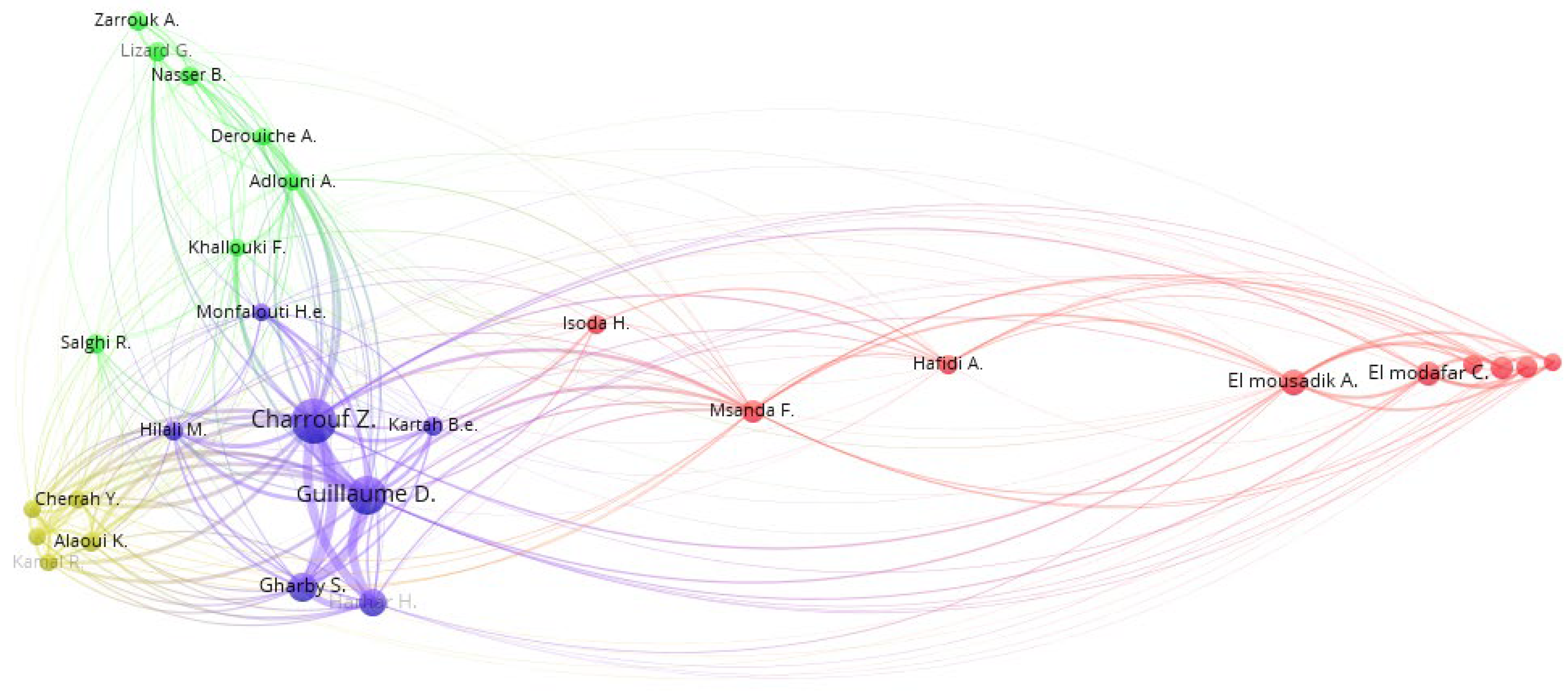
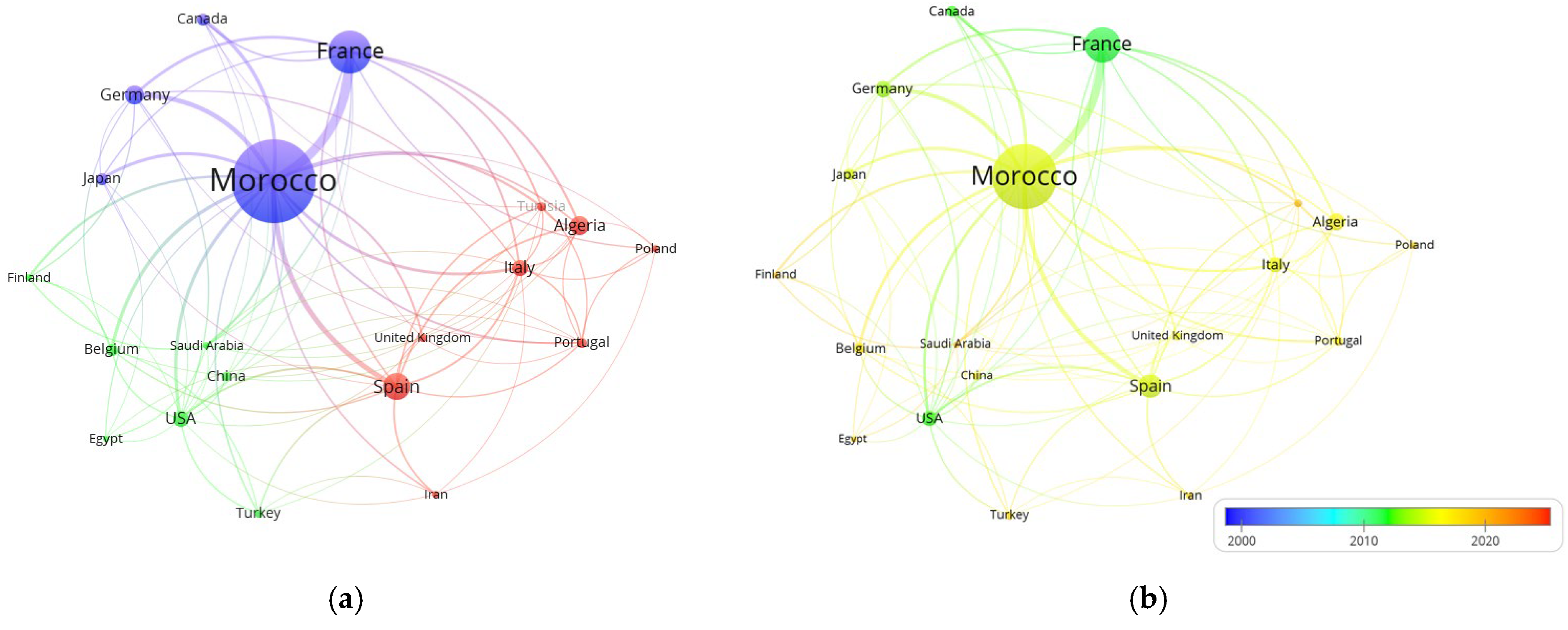
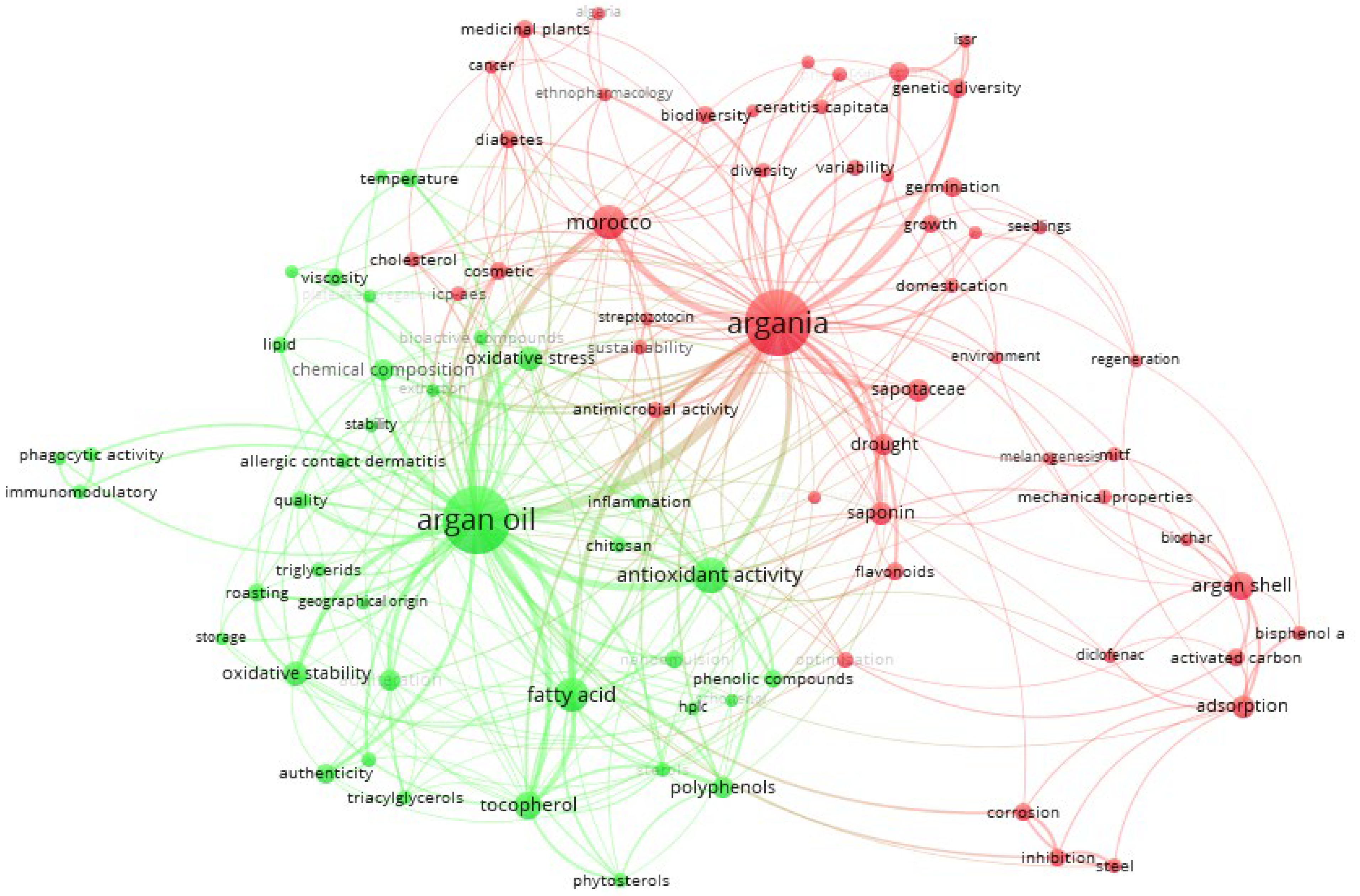
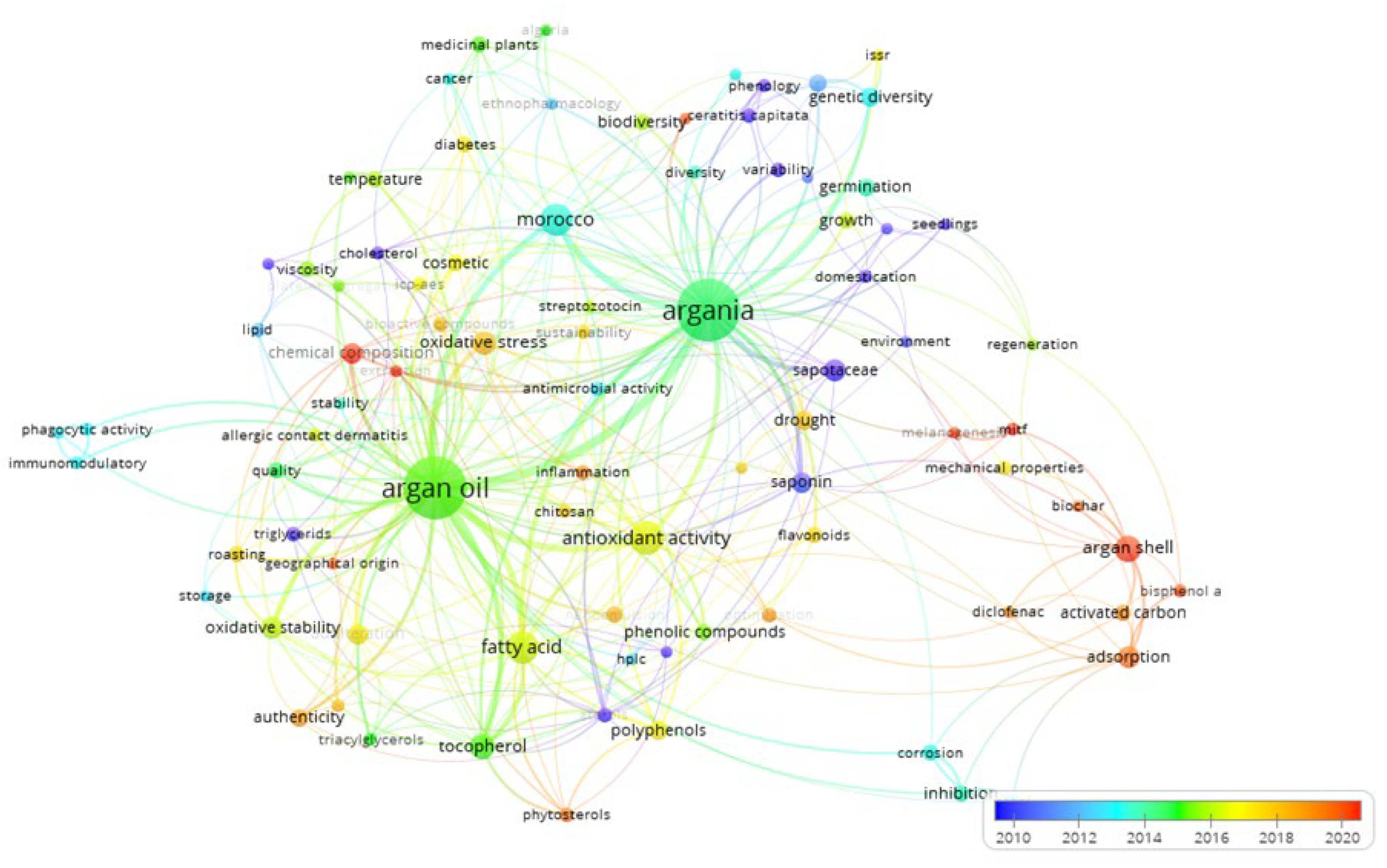

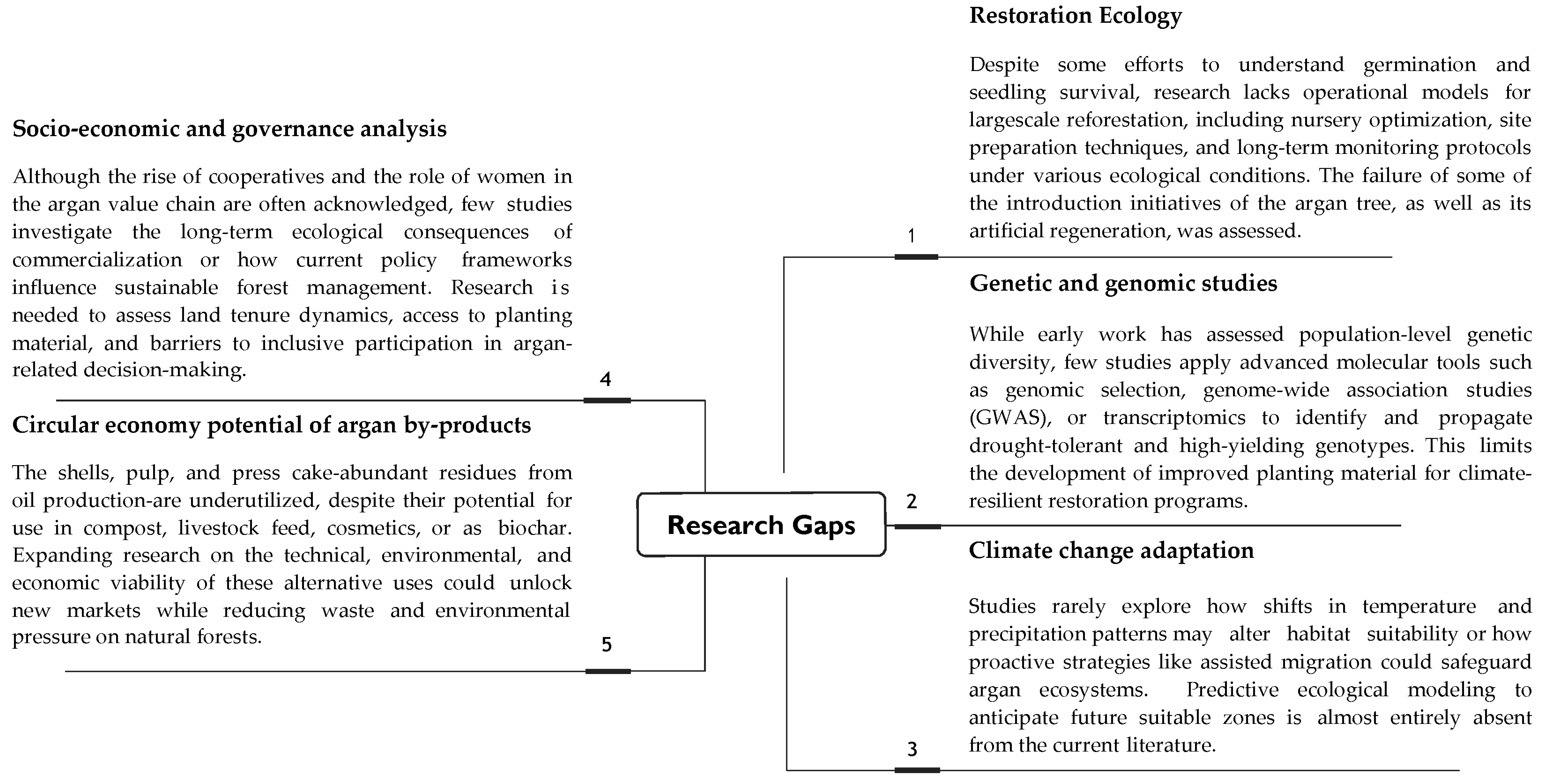
| Description | Results |
|---|---|
| Documents | 926 |
| Sources (journals, books, etc.) | 571 |
| Period | 1897 to 2024 |
| Document content | |
| Keywords Plus ID | 6652 |
| Author’s keyword descriptors | 2509 |
| Average citations per document | 18.86 |
| Authors | 2904 |
| Authors of single-authored documents | 74 |
| Authors of multi-authored documents | 2830 |
| Single-authored documents | 86 |
| Multi-authored documents | 840 |
| Documents per author | 0.32 |
| Authors per document | 3.14 |
| Co-Authors per document | 5.17 |
| Collaboration Index (CI) | 3.38 |
| Document types | |
| Articles | 757 |
| Book | 7 |
| Book chapter | 31 |
| Conference paper | 44 |
| Conference review | 4 |
| Data paper | 2 |
| Editorial | 3 |
| Letter | 5 |
| Note | 7 |
| Review | 66 |
Disclaimer/Publisher’s Note: The statements, opinions and data contained in all publications are solely those of the individual author(s) and contributor(s) and not of MDPI and/or the editor(s). MDPI and/or the editor(s) disclaim responsibility for any injury to people or property resulting from any ideas, methods, instructions or products referred to in the content. |
© 2025 by the authors. Licensee MDPI, Basel, Switzerland. This article is an open access article distributed under the terms and conditions of the Creative Commons Attribution (CC BY) license (https://creativecommons.org/licenses/by/4.0/).
Share and Cite
Timzioura, R.; Ezzine, S.; Benomar, L.; Lamhamedi, M.S.; Ettaqy, A.; Zine El Abidine, A.; Zaher, H.; Khasa, D.P.; Pepin, S.; Abbas, Y. Bibliometric Analysis of Argan (Argania spinosa (L.) Skeels) Research: Scientific Trends and Strategic Directions for Climate-Resilient Ecosystem Management. Forests 2025, 16, 892. https://doi.org/10.3390/f16060892
Timzioura R, Ezzine S, Benomar L, Lamhamedi MS, Ettaqy A, Zine El Abidine A, Zaher H, Khasa DP, Pepin S, Abbas Y. Bibliometric Analysis of Argan (Argania spinosa (L.) Skeels) Research: Scientific Trends and Strategic Directions for Climate-Resilient Ecosystem Management. Forests. 2025; 16(6):892. https://doi.org/10.3390/f16060892
Chicago/Turabian StyleTimzioura, Rajaa, Sara Ezzine, Lahcen Benomar, Mohammed S. Lamhamedi, Abderrahim Ettaqy, Abdenbi Zine El Abidine, Hafida Zaher, Damase P. Khasa, Steeve Pepin, and Younes Abbas. 2025. "Bibliometric Analysis of Argan (Argania spinosa (L.) Skeels) Research: Scientific Trends and Strategic Directions for Climate-Resilient Ecosystem Management" Forests 16, no. 6: 892. https://doi.org/10.3390/f16060892
APA StyleTimzioura, R., Ezzine, S., Benomar, L., Lamhamedi, M. S., Ettaqy, A., Zine El Abidine, A., Zaher, H., Khasa, D. P., Pepin, S., & Abbas, Y. (2025). Bibliometric Analysis of Argan (Argania spinosa (L.) Skeels) Research: Scientific Trends and Strategic Directions for Climate-Resilient Ecosystem Management. Forests, 16(6), 892. https://doi.org/10.3390/f16060892







